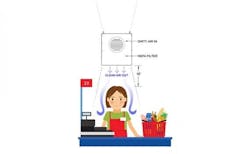Safety Halo Air-Cleaning Unit Protects Workers
"We Clean Air" is a line of air-cleaning devices designed specifically to protect people from contamination by airborne pathogens. Specializing in the manufacturing of Air-Cleaning Blowers, which clean air without the need for filter elements, the company was inspired by the need to protect cashiers, virus testers, and workers in food-preparation plants during the Covid-19 pandemic. Based on the design of air canopies used to protect coal miners from dust, We Clean Air developed units specifically to remove viruses that people exhale toward each other.
The first unit developed, the Safety Halo, creates a cone of protective air by blowing clean air gently downward over the person, products or whatever needs protecting. This moving air has a slight pressure sufficient to build a cone of air that flows both downward and outward. As a result, when people breathe germs in the direction of someone working under a Safety Halo, the exhaled particles are both resisted by the cone's wall-like air and caught by the flowing air and carried downward, away from the worker's face or work surface. The Safety Halos uses a HEPA filter as the final filter in the unit, to assure that the protective air is safer to breathe and more germ-free than the air cleaned by an N95 mask.
Safety Halos also remove rain, mist, and snow so they can be used indoors or outdoors; multiple units joined together protect a production line as well as multiple workers. They can hang from a ceiling or roof or be mounted stationary or movable on a stand to go wherever they are needed. Most Safety Halos will be used in workplaces, but they offer the same protection to homes, schools, ticket booths, and even wedding cakes.
Manufactured in New York State, the Safety Halos are designed for easy installation, operation, and maintenance. The Safety Halo is pending final testing by NIOSH (the National Institute of Occupational Safety and Health, a part of the CDC), and which supported their development.
